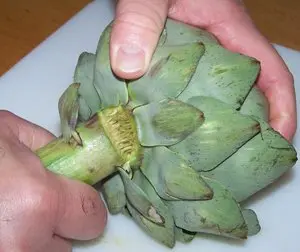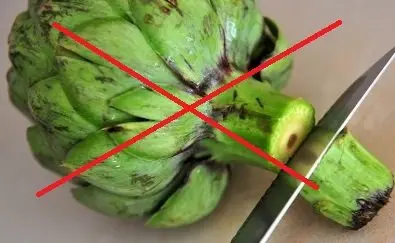This site uses only a few technical cookies necessary for its operation. By continuing to browse, you accept their use.
To find out more...
To find out more...
Artichoke stalks

When preparing artichokes for cooking, you may well already know that we often need to remove the first round of leaves, if they are tatty or dirty, as well as the inedible stalk. The operative word here is “remove” , rather than “cut off”.
53 K 4.3/5 (24 reviews)
Last modified on: October 25th 2016
Artichoke stalks
To show you better what I mean, here is what not to do:
Why? Well, it's because the artichoke stalk contains tough fibres that run up into the heart. These don't cook well (if at all) and are very unpleasant to eat. Cutting the stalk off with a knife, like in the photo, leaves the fibres in the heart intact.
Here's how to do it: do not cut the stalk, but break it off, as shown here:
Hold the artichoke firmly on the edge of a table with one hand, then bend the stalk sharply with the other hand until it breaks off, bringing with it most of the fibres I mentioned earlier. It is worth noting that this is much easier to do when the artichoke is really fresh. Once the stalk starts to soften, it will bend without breaking properly.
To sum up: When preparing an artichoke for cooking, do not cut the stalk, but break it off instead.
Important: it is quite different for the small purple artichokes, which can be eaten with their stalk (and everything else).

Why? Well, it's because the artichoke stalk contains tough fibres that run up into the heart. These don't cook well (if at all) and are very unpleasant to eat. Cutting the stalk off with a knife, like in the photo, leaves the fibres in the heart intact.
Here's how to do it: do not cut the stalk, but break it off, as shown here:

Hold the artichoke firmly on the edge of a table with one hand, then bend the stalk sharply with the other hand until it breaks off, bringing with it most of the fibres I mentioned earlier. It is worth noting that this is much easier to do when the artichoke is really fresh. Once the stalk starts to soften, it will bend without breaking properly.
To sum up: When preparing an artichoke for cooking, do not cut the stalk, but break it off instead.
Important: it is quite different for the small purple artichokes, which can be eaten with their stalk (and everything else).
Lasts posts
Butter vs. grease
We often read in a recipe where a pastry is put into a mould that, just before pouring, the mould should be buttered or greased. But what's the difference between these 2 terms?December 1st 20251,1025
Getting out of the fridge early
Very often when you're cooking, you need to take food or preparations out of the fridge, to use them in the recipe in progress. There's nothing tricky about this: you just take them out of the fridge and use them, usually immediately, in the recipe. But is this really a good method?November 24th 20251,1715
Who's making the croissants?
When you look at a bakery from the outside, you naturally think that in the bakery, the bakers make the bread, and in the laboratory, the pastry chefs make the cakes. It's very often like that, with each of these professions having quite different ways of working, but sometimes there's also one...November 23th 20251,073
Oven height
When we put a dish or cake in the oven, we naturally tend to put it on the middle shelf, and that's what we usually do. But in some cases, this position and height can be a little tricky, so let's find out why.October 8th 20252,8925
The importance of sieving
In recipes that use a fine powder (flour, powdered sugar, etc.), you'll often see the advice to sift before using it. To sift is to pass the powder in question through a sieve (a very fine strainer) before incorporating it into your recipe. It's often advice, but is it really useful?September 3rd 20257,6203
Other pages you may also like
Fruits which can ruin your jelly
There are many ways of making a fruit mousse, but one of the simplest is to prepare a fruit jelly (basically a fresh fruit coulis with gelatine) and then mix this jelly before it sets completely with whipped cream. The result is perfect for filling a charlotte, for example. But do beware;...March 6th 201378 K4.0
Kitchen ovens
You certainly have one in your kitchen, an oven, the essential tool for all kinds of cooking, whether in the kitchen of course, but also in pastry, bakery, pizza, and many others. Here is some information on its structure and operation.May 16th 202034 K4.4
The window-pane test in bread-making
The home bread-makers often ask themselves “Have I kneaded my dough long enough?” . A good question, as dough that is insufficiently kneaded will not rise properly or will fall flat when the top is slashed, which is very frustrating. To know when the dough is ready, one can rely on the length...June 16th 202197 K 23.9
What is the difference between bakery and patisserie?
This is a question that you may well have asked yourself and which I will attempt to answer. In France the two trades of "boulangerie" (bakery) and "pâtisserie" (patisserie and confectionery) have always been quite distinct, but where exactly do the boundaries lie? .February 7th 2017134 K 14.1
Candied fruits: don't get ripped off
Do you like candied fruit? You might like to nibble a handful or add it to a recipe, like a classic fruit cake or delicious Italian specialities like panettone or sicilian epiphany pie.June 21th 201767 K 24.2
Post a comment or question
Follow this page
If you are interested in this page, you can "follow" it, by entering your email address here. You will then receive a notification immediately each time the page is modified or a new comment is added. Please note that you will need to confirm this following.
Note: We'll never share your e-mail address with anyone else.
Alternatively: you can subscribe to the mailing list of cooling-ez.com , you will receive a e-mail for each new recipe published on the site.









